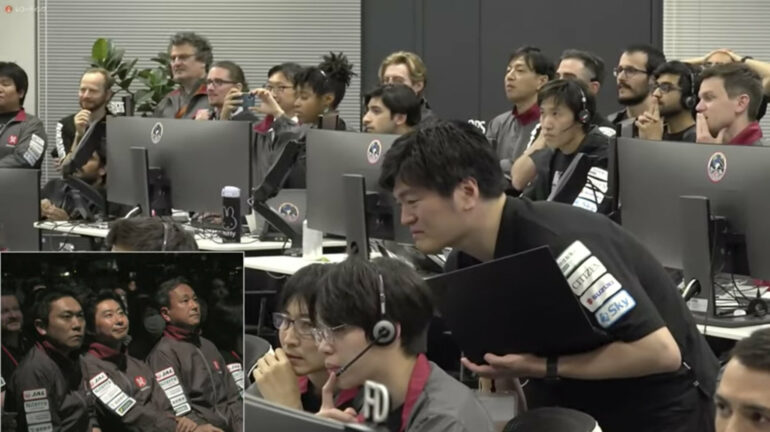A Japanese company’s spacecraft apparently crashed while attempting to land on the moon Wednesday, losing contact moments before touchdown and sending flight controllers scrambling to figure out what happened.
More than six hours after communication ceased, the Tokyo company ispace finally confirmed what everyone had suspected, saying there was “a high probability” that the lander had slammed into the moon.
It was a disappointing setback for ispace, which after a 4 1/2-month mission had been on the verge of doing what only three countries have done: successfully land a spacecraft on the moon.
Takeshi Hakamada, founder and CEO of ispace, held out hope even after contact was lost as the lander descended the final 33 feet (10 meters). Flight controllers peered at their screens in Tokyo as minutes went by with only silence from the moon.
A grim-faced team surrounded Hakamada as he announced that the landing likely failed.
Official word finally came in a statement: “It has been determined that there is a high probability that the lander eventually made a hard landing on the moon’s surface.”
If all had gone well, ispace would have been the first private business to pull off a lunar landing. Hakamada vowed to try again, saying a second moonshot is already in the works for next year.
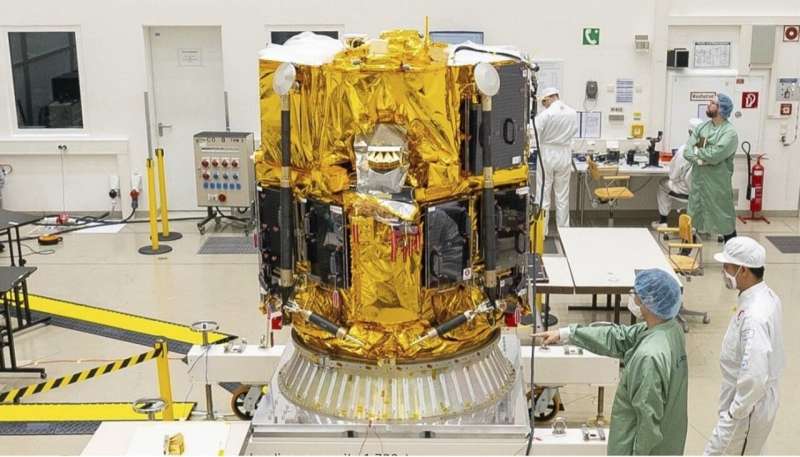
In this photo provided by ispace, inc., ispace engineers and affiliates work on the flight model of the HAKUTO-R Mission 1 Lunar Lander at the IABG Space Test Centre in Ottobrunn, Germany, in August 2022. A Japanese company’s spacecraft apparently crashed while attempting to land on the moon Wednesday, April 26, 2023, losing contact moments before touchdown and sending flight controllers scrambling to figure out what happened. © ispace, inc. via AP
Only three governments have successfully touched down on the moon: Russia, the United States and China. An Israeli nonprofit tried to land on the moon in 2019, but its spacecraft was destroyed on impact.
“If space is hard, landing is harder,” tweeted Laurie Leshin, director of NASA’s Jet Propulsion Laboratory. “I know from personal experience how awful this feels.”
Leshin worked on NASA’s Mars Polar lander that crashed on the red planet in 1999.
The 7-foot (2.3-meter) Japanese lander carried a mini lunar rover for the United Arab Emirates and a toylike robot from Japan designed to roll around in the moon dust for about 10 days. That was also the expected length of the full mission.
Named Hakuto, Japanese for white rabbit, the spacecraft had targeted the Atlas crater in the northeastern section of the moon’s near side, more than 50 miles (87 kilometers) across and just over 1 mile (2 kilometers) deep.
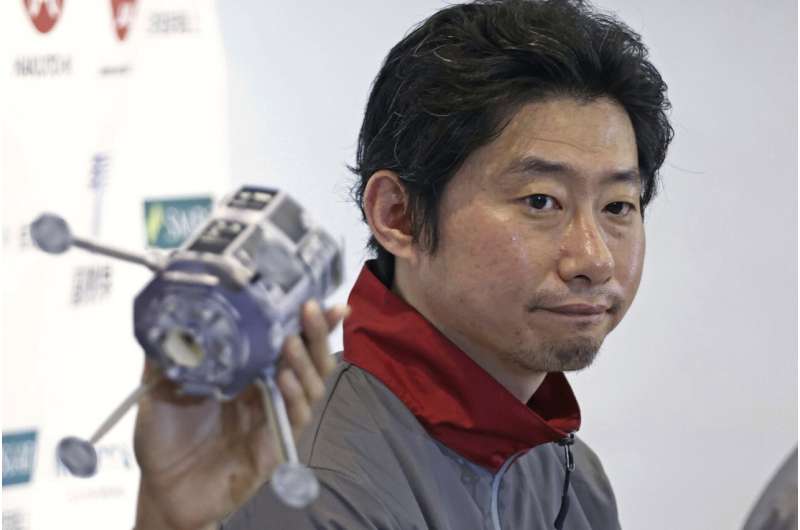
Takeshi Hakamada, founder and CEO of ispace, attends a press conference with a model of a lunar lander in Tokyo Wednesday, April 26, 2023. A Japanese company’s spacecraft apparently crashed while attempting to land on the moon Wednesday, losing contact moments before touchdown and sending flight controllers scrambling to figure out what happened. It’s possible the lander miscalculated its altitude and ran out of fuel before reaching the surface, company officials said at a news conference. © Kyodo News via AP
It took a roundabout route to the moon following its December liftoff, beaming back photos of Earth along the way. The lander entered lunar orbit on March 21.
Flight controllers ascertained that the lander was upright as it used its thrusters to slow during Wednesday’s final approach. Engineers monitoring the fuel gauge noticed that as the tank approached empty, the lander picked up speed as it descended and communication was then lost, according to ispace.
It’s possible the lander miscalculated its altitude and ran out of fuel before reaching the surface, company officials said at a news conference later in the day.
Founded in 2010, ispace hopes to start turning a profit as a one-way taxi service to the moon for other businesses and organizations. The company has already raised $300 million to cover the first three missions, according to Hakamada.

Takeshi Hakamada, founder and CEO of ispace, speaks at the end of the livestream of the HAKUTO-R private lunar exploration program at the lunar landing event Wednesday, April 26, 2023, at Miraikan, the National Museum of Emerging Science and Innovation, in Tokyo. Tokyo’s ispace tried to land its own spacecraft on the moon early on Wednesday, but its fate was unknown as flight controllers lost contact with it moments before the planned touchdown. © AP Photo/Eugene Hoshiko

Staff watch the livestream of HAKUTO-R private lunar exploration program on screen during the lunar landing event Wednesday, April 26, 2023, at Miraikan, the National Museum of Emerging Science and Innovation, in Tokyo. Tokyo’s ispace company put its own spacecraft into orbit around the moon a month ago. Flight controllers will direct the craft, named Hakuto, Japanese for white rabbit, to descend from 60 miles (100 kilometers) high and land on Wednesday.© AP Photo/Eugene Hoshiko

Takeshi Hakamada, right, founder and CEO of ispace, speaks at a press conference in Tokyo Wednesday, April 26, 2023. A Japanese company’s spacecraft apparently crashed while attempting to land on the moon Wednesday, losing contact moments before touchdown and sending flight controllers scrambling to figure out what happened. It’s possible the lander miscalculated its altitude and ran out of fuel before reaching the surface, company officials said at a news conference. © Kyodo News via AP
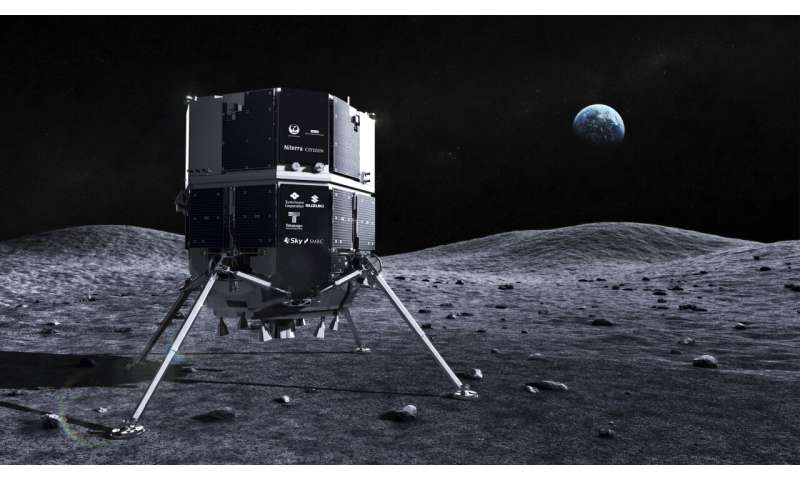
This illustration provided by ispace in April 2023 depicts the Hakuto spacecraft on the surface of the moon with the Earth in the background. On Tuesday, April 25, 2023, flight controllers plan to direct the craft to descend from orbit and land on the moon’s surface. © ispace via AP
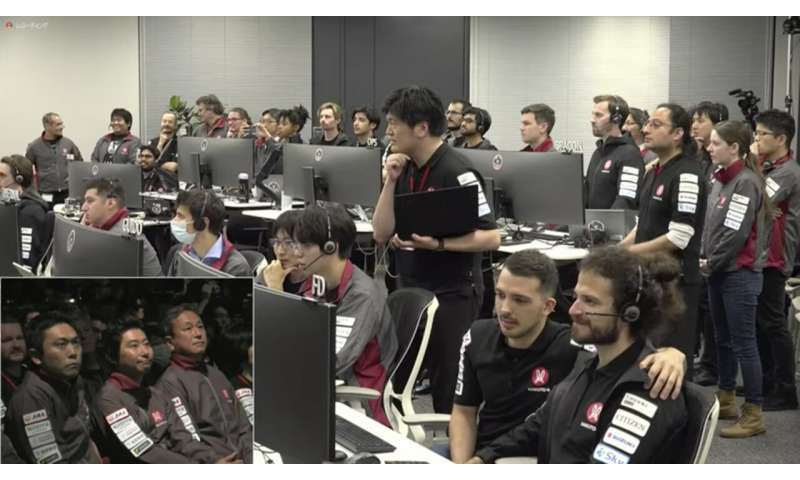
In this image from video provided by ispace, flight controllers in Tokyo wait for a signal from the company’s Hakuto spacecraft after a landing attempt on the surface of the moon, early Wednesday, April 26, 2023. Inset image at bottom left shows Takeshi Hakamada, founder and CEO of the company, center. © ispace via AP
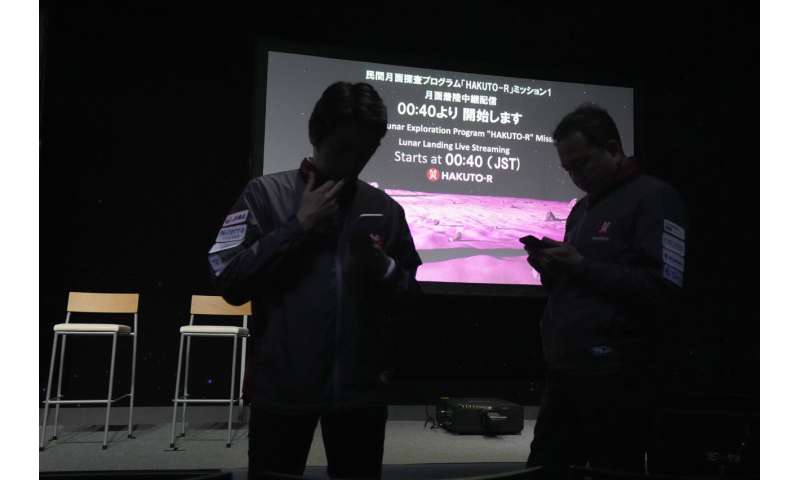
Staff stand in front of the screen prior to livestream of the lunar landing event Wednesday, April 26, 2023, at Miraikan, the National Museum of Emerging Science and Innovation, in Tokyo. Tokyo’s ispace company put its own spacecraft into orbit around the moon a month ago. Flight controllers will direct the craft, named Hakuto, Japanese for white rabbit, to descend from 60 miles (100 kilometers) high and land on Wednesday. © AP Photo/Eugene Hoshiko
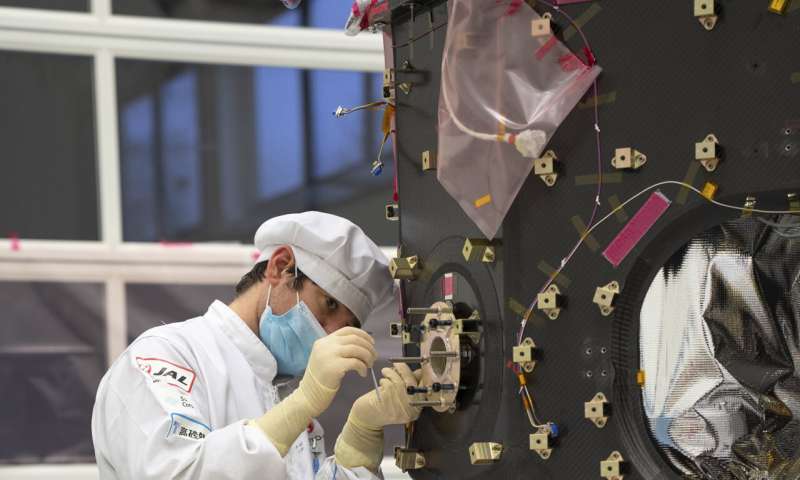
In this photo provided by ispace in April 2023, a technician works on the Hakuto spacecraft in Japan. On Tuesday, April 25, 2023, flight controllers plan to direct the craft to descend from orbit and land on the moon’s surface. © ispace via AP
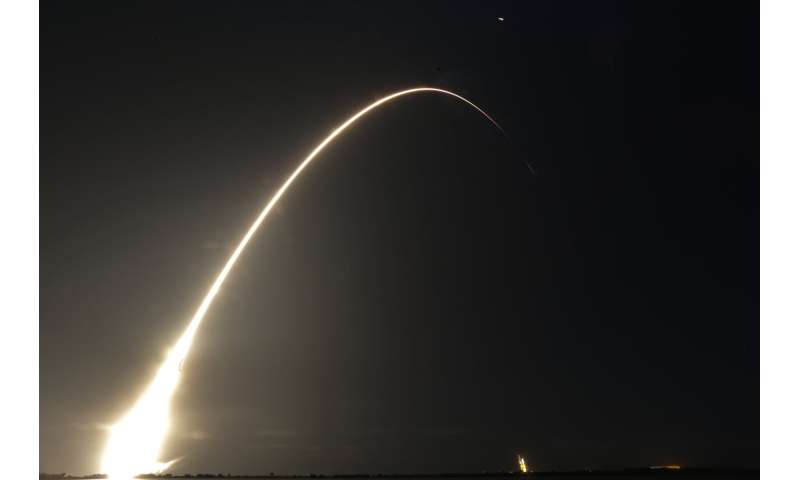
This time exposure photo shows a SpaceX Falcon 9 rocket, with a payload including two lunar rovers from Japan and the United Arab Emirates, launching from Launch Complex 40 at the Cape Canaveral Space Force Station in Cape Canaveral, Fla., on Dec. 11, 2022. A Japanese company’s spacecraft apparently crashed while attempting to land on the moon Wednesday, April 26, 2023, losing contact moments before touchdown and sending flight controllers scrambling to figure out what happened. © AP Photo/John Raoux, File
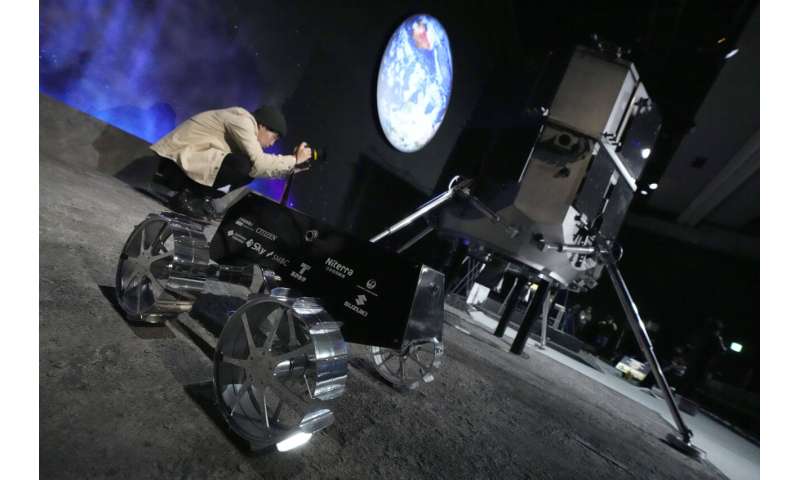
A photographer shoots the models of the lander and the lunar rover of HAKUTO-R private lunar exploration program prior to livestream of the lunar landing event Wednesday, April 26, 2023, at Miraikan, the National Museum of Emerging Science and Innovation, in Tokyo. Tokyo’s ispace company put its own spacecraft into orbit around the moon a month ago. Flight controllers will direct the craft, named Hakuto, Japanese for white rabbit, to descend from 60 miles (100 kilometers) high and land on Wednesday. © AP Photo/Eugene Hoshiko
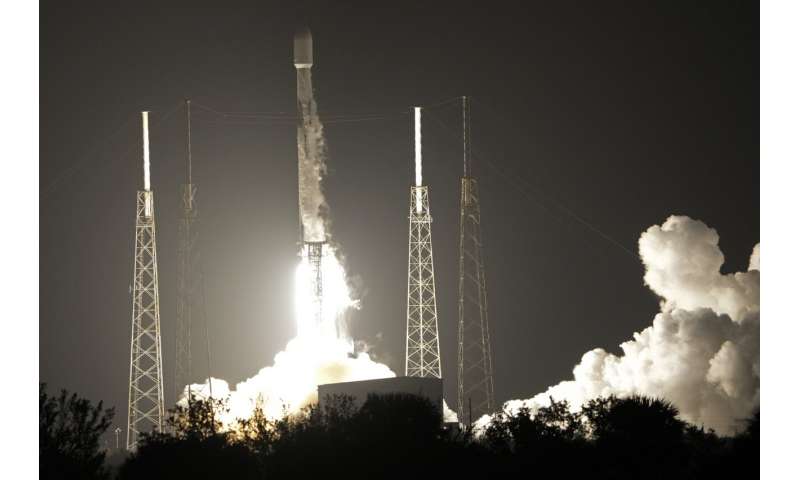
A SpaceX Falcon 9 rocket, with a payload including two lunar rovers from Japan and the United Arab Emirates, lifts off from Launch Complex 40 at the Cape Canaveral Space Force Station in Cape Canaveral, Fla., on Dec. 11, 2022. A Japanese company’s spacecraft apparently crashed while attempting to land on the moon Wednesday, April 26, 2023, losing contact moments before touchdown and sending flight controllers scrambling to figure out what happened. © AP Photo/John Raoux, File
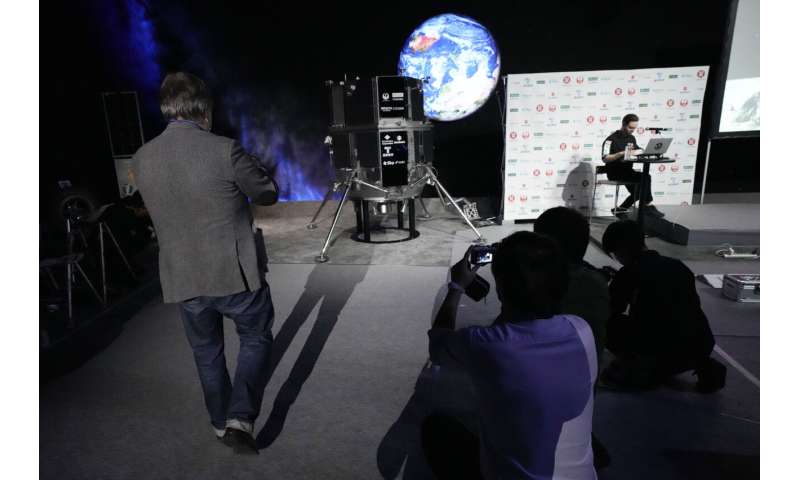
Journalist film the models of the lander and the lunar rover of HAKUTO-R private lunar exploration program prior to livestream of the lunar landing event Wednesday, April 26, 2023, at Miraikan, the National Museum of Emerging Science and Innovation, in Tokyo. Tokyo’s ispace company put its own spacecraft into orbit around the moon a month ago. Flight controllers will direct the craft, named Hakuto, Japanese for white rabbit, to descend from 60 miles (100 kilometers) high and land on Wednesday. © AP Photo/Eugene Hoshiko
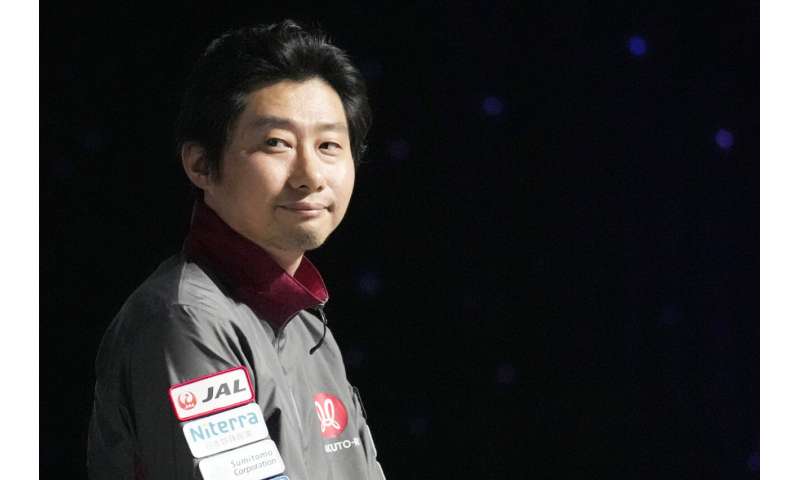
Takeshi Hakamada, founder and CEO of ispace attends livestream of HAKUTO-R private lunar exploration program on screen during the lunar landing event Wednesday, April 26, 2023, at Miraikan, the National Museum of Emerging Science and Innovation, in Tokyo. Tokyo’s ispace company put its own spacecraft into orbit around the moon a month ago. Flight controllers will direct the craft, named Hakuto, Japanese for white rabbit, to descend from 60 miles (100 kilometers) high and land on Wednesday. © AP Photo/Eugene Hoshiko
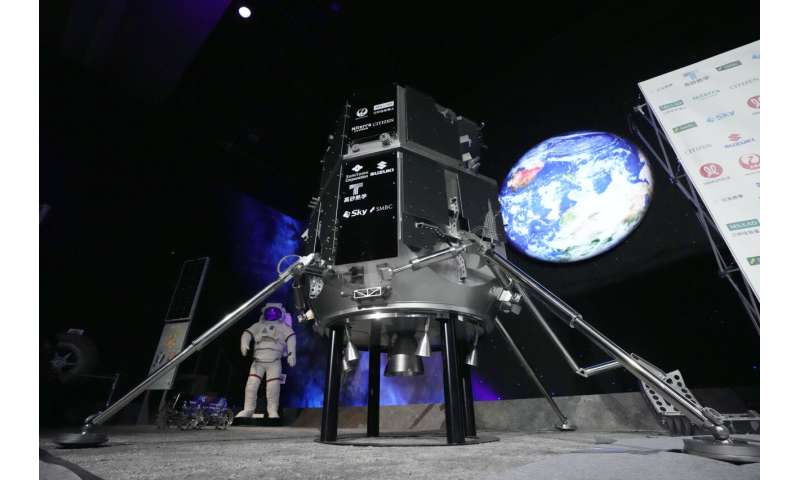
A model of the lander of HAKUTO-R private lunar exploration program is displayed prior to livestream of the lunar landing event Wednesday, April 26, 2023, at Miraikan, the National Museum of Emerging Science and Innovation, in Tokyo. Tokyo’s ispace company put its own spacecraft into orbit around the moon a month ago. Flight controllers will direct the craft, named Hakuto, Japanese for white rabbit, to descend from 60 miles (100 kilometers) high and land on Wednesday. © AP Photo/Eugene Hoshiko
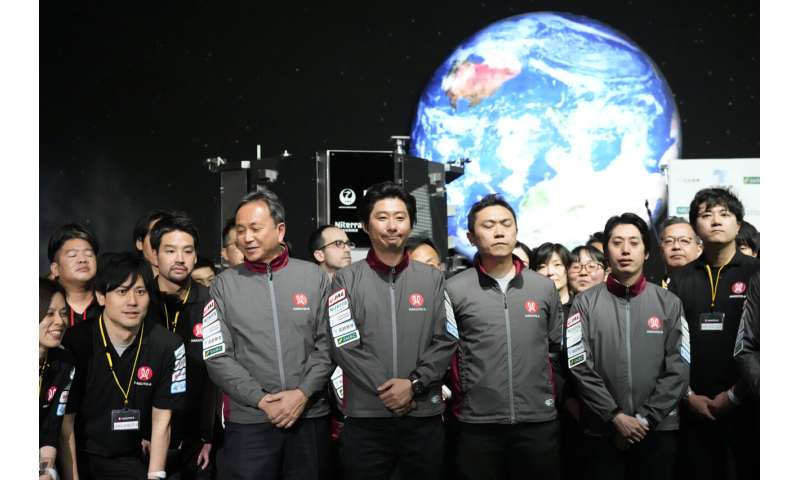
Takeshi Hakamada, center, founder and CEO of ispace, and his team staff gather for photo session after livestream of HAKUTO-R private lunar exploration program on screen at the lunar landing event Wednesday, April 26, 2023, at Miraikan, the National Museum of Emerging Science and Innovation, in Tokyo. Tokyo’s ispace tried to land its own spacecraft on the moon early on Wednesday, but its fate was unknown as flight controllers lost contact with it moments before the planned touchdown. © AP Photo/Eugene Hoshiko
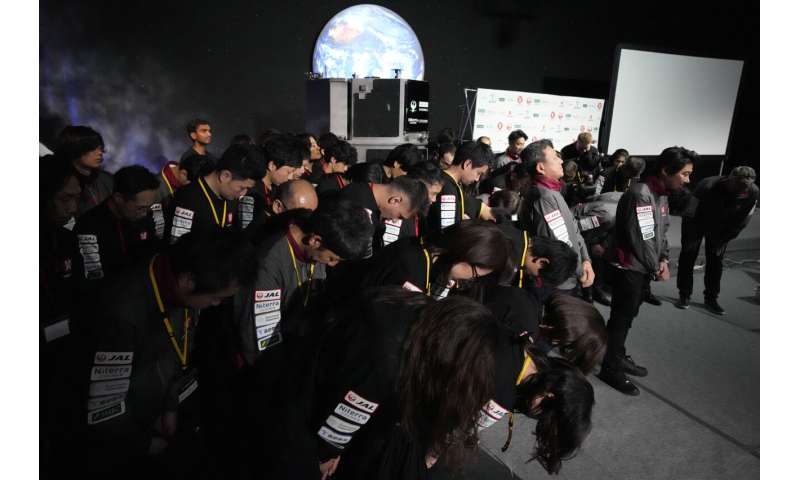
Takeshi Hakamada, founder and CEO of ispace, right, and his team staff bow at the end of livestream of HAKUTO-R private lunar exploration program on screen at the lunar landing event Wednesday, April 26, 2023, at Miraikan, the National Museum of Emerging Science and Innovation, in Tokyo. Tokyo’s ispace tried to land its own spacecraft on the moon early on Wednesday, but its fate was unknown as flight controllers lost contact with it moments before the planned touchdown. © AP Photo/Eugene Hoshiko
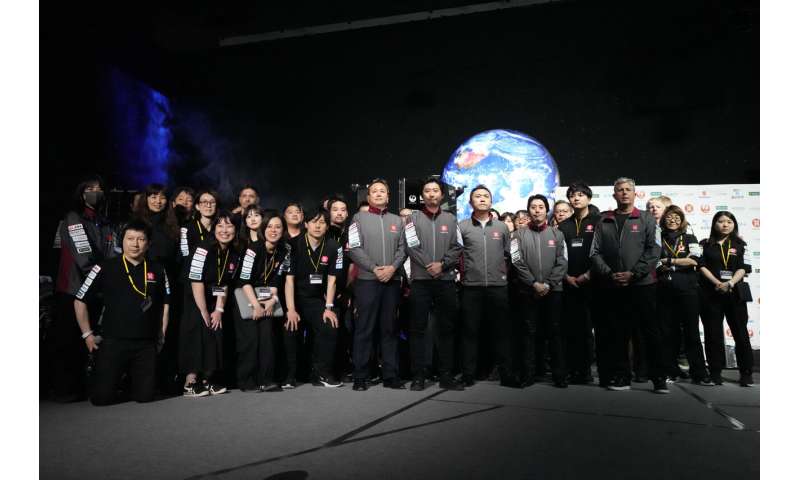
Staff of ispace gather for photo session at the end of livestream of HAKUTO-R private lunar exploration program on screen at the lunar landing event Wednesday, April 26, 2023, at Miraikan, the National Museum of Emerging Science and Innovation, in Tokyo. Tokyo’s ispace tried to land its own spacecraft on the moon early on Wednesday, but its fate was unknown as flight controllers lost contact with it moments before the planned touchdown. © AP Photo/Eugene Hoshiko
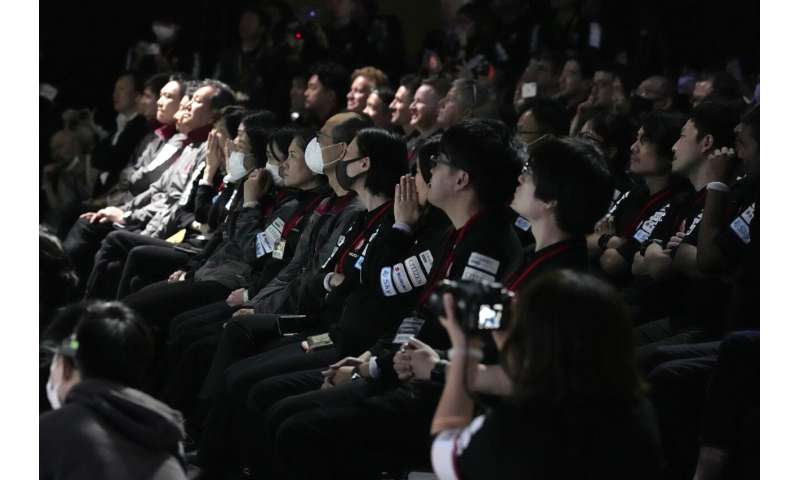
Takeshi Hakamada, founder and CEO of ispace, right, and his team staff watch livestream of HAKUTO-R private lunar exploration program on screen at the lunar landing event Wednesday, April 26, 2023, at Miraikan, the National Museum of Emerging Science and Innovation, in Tokyo. Tokyo’s ispace tried to land its own spacecraft on the moon early on Wednesday, but its fate was unknown as flight controllers lost contact with it moments before the planned touchdown. © AP Photo/Eugene Hoshiko
“We will keep going, never quit lunar quest,” he said.
For this test flight, the two main experiments were government-sponsored: the UAE’s 22-pound (10-kilogram) rover Rashid, named after Dubai’s royal family, and the Japanese Space Agency’s orange-sized sphere designed to transform into a wheeled robot on the moon. The UAE—already in orbit around Earth with an astronaut aboard the International Space Station and in orbit around Mars—was seeking to extend its presence to the moon.
The moon is suddenly hot again, with numerous countries and private companies clamoring to get on the lunar bandwagon. China has successfully landed three spacecraft on the moon since 2013, and U.S., China, India and South Korea have satellites currently circling the moon.
NASA’s first test flight in its new moonshot program, Artemis, made it to the moon and back late last year, paving the way for four astronauts to follow by the end of next year and two others to actually land on the moon a year after that. Pittsburgh’s Astrobotic Technology and Houston’s Intuitive Machines have lunar landers waiting in the wings, poised to launch later this year at NASA’s behest.
Hakuto and the Israeli spacecraft named Beresheet were finalists in the Google Lunar X Prize competition requiring a successful landing on the moon by 2018. The $20 million grand prize went unclaimed.
2023 The Associated Press. All rights reserved. This material may not be published, broadcast, rewritten or redistributed without permission.
Citation:
Japanese company: ‘High probability’ lander crashed on moon (2023, April 26)
